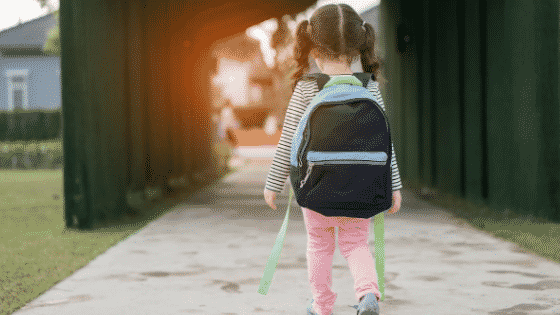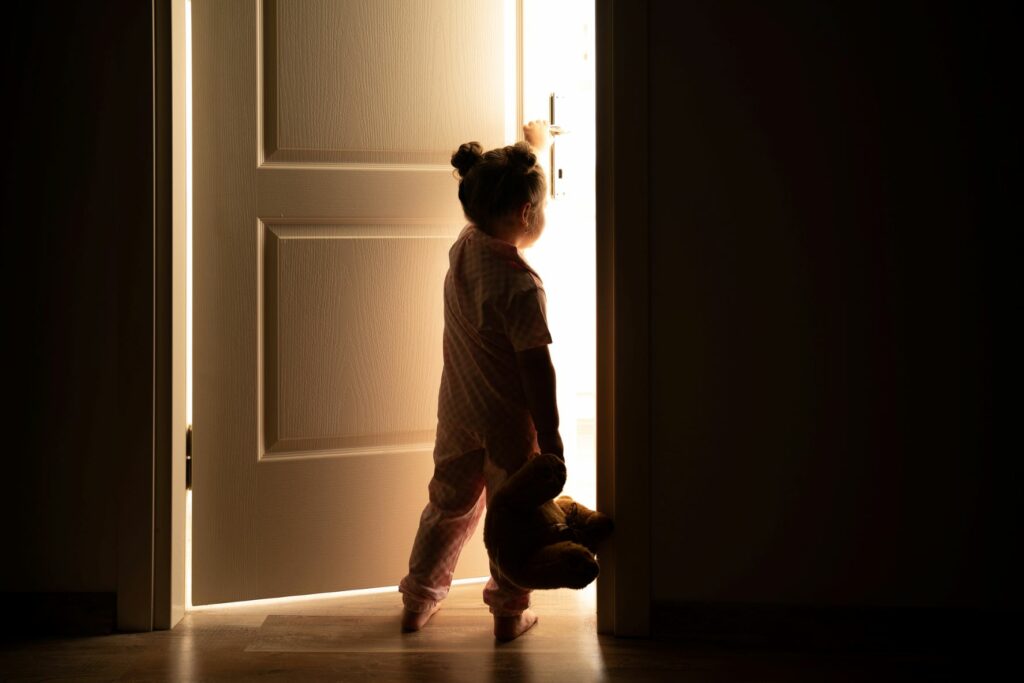Back-to-School COVID Sleep Tips
The following tips will help jump-start your family into that back to school routine and focus on getting everyone well rested for the big changes ahead.
1. Plan ahead and communicate the changes, have a family meeting!
Communicate with your children, have a family meeting discussing why the routine is changing and why everyone needs to get their sleep back on track. Whether it is your kindergartener or your teenager, chat with them about why our body needs sleep and what changes happen while our body sleeps. There are some great books and videos that you can share with your kids to help them understand that we aren’t just “trying to get them to bed” but really, we are helping their bodies and minds grow. Having open communication about the back to school transition and setting family goals on how to make the transition easier, helps to involve them and keep them on board with the changes.
2. Reset your child’s internal clock
During those summer months, we often have a later bedtime and those lazy morning sleep-ins which can be hard to change. Start early, starting a few weeks before school starts can help to get your child back on track and help to reset their internal clock. Get back to an early bedtime and start waking them a bit earlier each day until you are at that morning wake time for back to school. This initially includes weekends too, so you should stick to those bedtimes and wake times during the transition.
If you have a little one who is just starting preschool or kindergarten those busy first few weeks can be even more challenging for them. For the first month or two, make sure to limit extra activities and offer an earlier bedtime to help them with the transition.
3. Know how much sleep your child needs for their age:
February 2015, The National Sleep Foundation recommended new nightly sleep durations for all ages:
Preschoolers (3-5): 10-13 hours per night. Recommended age-appropriate bedtime of 7-8:00 pm.
School-age children (6-13): 9-11 hours per night. Recommended age-appropriate bedtime of 8-9:30 pm.
Teenagers (14-17): 8-10 hours. Recommend encouraging bedtime starting at 9:30-11 pm. Bedtime would depend on the school start time or morning activities.
4. Bring Back Bedtime Routine
A bedtime routine of similar activities that are done each night helps prepare the body for bed and release melatonin, our sleepy hormone. A few weeks before school, begin a consistent bedtime routine that allows enough time for wind-down activities and some connection time after those busy days. Some great wind-down activities you can do together are colouring, reading a book together, a shared journal, or even some simple meditation or yoga.
5. Establish a Good Sleep Environment
Back to school is a great time to look at our sleep environments and ensure we are providing a sleep environment that is conducive to sleep and free of distractions. We want to ensure our space is free of clutter and inviting for sleep. That may mean rearranging furniture, taking out toys or electronics, and maybe even sprucing up the bedroom with new paint or bedding. When our bedroom space is inviting it can really encourage that relaxing space that is ready for sleep. There are some key components we want to look at when making these changes to our child or teen’s sleep environment
- Have a proper alarm clock. An alarm clock can give our child/teen control over setting it and getting up each morning.
- Bedding, having a cozy space including proper pillows and bedding can make any space more inviting. Create a bedtime nook for bedtime education and stories.
- Blackout blinds or curtains – this can help our kids and teens get to bed and sleep during those lighter days, and can help our teens who may need that extra sleep and sleep longer in the mornings
- White noise – white noise is a great tool if you have a child or teen that may have trouble blocking out those other sounds and settling to sleep. White noise can be soothing and can help us settle back to sleep easier if we wake in the night.
- Tools for sleep – this may be a meditation app, some books to read before bed, yoga or deep breathing cards, a journal, or some colouring. Having a special basket of these activities that can be used during the bedtime routine is great for relaxing our body and mind as we get ready for sleep. We want to have some time for quiet reflection and relaxation before bed and having these tools ready beside the bed can really help this.
6. Make Tech Habit Changes
This is especially important for middle school and high schoolers. Create a family docking station so that electronics such as phones and iPads are not coming into the bedrooms. Having a family docking station can make sure everyone’s tech is docked at least an hour before bedtime. It can be hard to wind down with stimulating activities, like TV, computer games, and Internet usage. Screen time can disrupt the melatonin production and can make it harder for children to calm down and leave those screens behind.
7. Address Those Back to School Feelings
There have been so many changes these last few months to our kids’ schedules and routines, especially in regard to school. With this, we can anticipate that the back to school transition will not only involve changes to these routines and expectations, but we may also see anxiety and stress levels increase during this time. Anxiety and stress often come from not knowing what to expect or what our new normal will look like. When we are unsure of what is to come, it’s normal for our minds and bodies to feel this. For kids and teens, this often comes out in the form of behaviours, difficulty with sleep, and/or challenges around that back to school routine.
8. Understand your child’s feelings and needs
Through all these changes and unprecedented times, our children have looked to us for guidance and support to help them navigate this new world. By supporting and leading them through this we are also supporting their anxiety and mental health. So how can we lead? How can we support them through this back to school transition and the new reality that awaits them there? Here are some steps to connect with our kids and their school to help those big changes feel less overwhelming.
What parents can do?
- Discuss those big feelings. Whether through books, drawing, journaling, or just talking, help to guide them through those feelings and expressing them. When we work through our feelings they are less likely to overwhelm us through all the changes. This connection is also so important for their sleep and being rested.
- Draw those connections to school. Through friends, teachers, or even the physical space, help them to connect. Visit the school grounds, ask about a virtual chat or visit to the school, make a “what I love about school book” and schedule some playdates or meetups with friends. All of these things help to bridge that gap and create connections. Those connections are what is going to get us through those first few weeks and they are what will help our children be excited for what is to come.
- Share the changes with them – While we can often be scared that talking too much about things can increase our child or teen’s anxiety and stress level, often the opposite is true. The unknown is scary. Share what we DO know and what we don’t, invite questions, share your own thoughts with them as they share theirs. Again, look to open that connection and give them what information we do have. Information is power, it helps us to feel in control and be ready for what is ahead.
- Let them know you’ve got them! What if it happens again, what if it’s hard and scary? Let them know you’ve got them and they are safe. That together you will work through it all and it will be okay. They need to hear this and we need to feel this!
Here is some more specific information based on your child’s age:
Kindergarten/primary grades – At this age, little ones often struggle because they don’t quite have all that understanding and language to express the changes and discomfort that may come from heading back to school and into those routines that have now become unfamiliar. Support here may come through togetherness, opening up that conversation, drawing/colouring/or journaling to help them express themselves and get those feelings out. Incorporating some time to work on some meditation, yoga, visualization, and/or journaling may be helpful to stay connected and give them an outlet through these changes. Give them the tools for what they can do if they are feeling worried or anxious, breathing cards are a great tool to practice relaxing our body when we are feeling stressed or overwhelmed. Your local library and librarian are a great resource to get some books on feelings, yoga, meditation to again open the conversation and work on some new skills. Make a visual schedule for your morning or bedtime routine. Visuals are a great way to have kids feel supported and know the expectations of what is to come. Involve them in the change, have them help make the new schedule and choose some activities you can do together as part of the bedtime routine. Make time for connection, these times are going to be overwhelming for us all. Schedule in that time for connection and support so we can all ease through it.
Middle school – This age can be challenging in that often the changes and anxiety around them can come out as defiance and resistance. Open the communication, have the patience to work through what they may be feeling and what may be at the root of those behaviours. Here it may be helpful to draw connections to the friends and activities they may be looking forward to returning to school. Discuss goals for the next year, teams they may want to try out for, courses they are looking forward to. By opening that communication and bringing back those family activities it can work to ease them into the transition. This age understands the challenges and the impact it has had on those social networks. Try to bridge those connections in the weeks before school starts and ask what might help ease the transition for them. Maybe it’s a drive past the school, making a back to school checklist or getting those back to school supplies ready. When they feel better prepared and equipped for the changes, we can expect them to have less resistance to what is to come.
Highschool – Help them to see what the changes are going to look like, which may involve more online classes and less time at school which may be hard for teens who are social beings. Look at how they can still be involved, what activities can they still be involved in whether virtually or in-person that can bridge those connections. Support them to reach out to friends or the school for the supports they may need and the concerns they have going forward. Again, when we can give them some control over the changes they are less likely to struggle through them.
What we can do when trouble arises?
- Have a family meeting, talk about the challenges, and what our expectations are for sleep. Develop some family sleep rules and a plan to achieve them together. Make a visual schedule for the bedtime routine and involve them in the steps.
- Look at your schedule, are they getting enough sleep? Can you bump bedtime earlier?
- Look at those strategies for helping them fall to sleep, incorporate some mindfulness, deep breathing, yoga, or visualization to work on relaxing their body and mind from a busy day. Build these into the end of the day and do them together to create that connection and downtime at the end of the day.
- Create a shared journal where they can write down their worries or struggles and we can read it. It can be hard to express those feelings or fears so having this outlet can be great for them.
- Look at where tech is happening and could it be affecting sleep? We typically recommend no tech at least an hour before bed. Each child is different but we also want to ensure they aren’t watching shows or playing games that are too stimulating which can also affect them settling to sleep and may even cause night wakings.
- For early or night wakings try a gro clock or alarm clock to help them understand the time and to stay in bed until a set time or until the sun comes up
9. Stick to it!
Remember consistency is everything, have a meeting and set those boundaries and follow through. Once we are back on track and into the groove it can be easy to get sidetracked by extra-curricular activities, homework, and wanting to have some family time. Healthy sleep and a bedtime routine can sometimes become lost in the shuffle of our busy days. Make sleep a priority every day, have visuals to remind everyone of the bedtime routine and sleep rules. Finally, make sure your child isn’t overscheduled, this can affect their sleep and how long it takes them to wind down in the evenings.
- If they have extra activities, plan them carefully. Don’t have something every night and try to plan them on the weekends where school days won’t be as affected.
- Watch for signs that your child may be overtired and/or over-scheduled. Have regular check-ins with them to see how they are feeling and how their sleep is going.
Schedule days off just like you would schedule activities. Having that planned downtime as a family can benefit everyone and shows the value of self-care and sleep.











